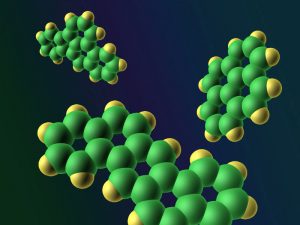 PAHs are often byproducts of petroleum processing or combustion. Many of these compounds are highly carcinogenic at relatively low levels. Although they are relatively insoluble in water, their highly hazardous nature merits their positioning in potable waters and waste waters.
PAHs are often byproducts of petroleum processing or combustion. Many of these compounds are highly carcinogenic at relatively low levels. Although they are relatively insoluble in water, their highly hazardous nature merits their positioning in potable waters and waste waters.
What happens to polycyclic aromatic hydrocarbons when they enter the environment?
- PAHs enter the air mostly as releases from volcanoes, forest fires, burning coal, and automobile exhaust.
- PAHs can occur in air attached to dust particles.
- Some PAH particles can readily evaporate into the air from soil or surface waters.
- PAHs can break down by reacting with sunlight and other chemicals in the air, over a period of days to weeks.
- PAHs enter water through discharges from industrial and wastewater treatment plants.
- Most PAHs do not dissolve easily in water. They stick to solid particles and settle to the bottoms of lakes or rivers.
- Microorganisms can break down PAHs in soil or water after a period of weeks to months.
- In soils, PAHs are most likely to stick tightly to particles; certain PAHs move through soil to contaminate underground water.
- PAH contents of plants and animals may be much higher than PAH contents of soil or water in which they live.
Exposure to polycyclic aromatic hydrocarbons usually occurs by breathing air contaminated by wild fires or coal tar, or by eating foods that have been grilled. PAHs have been found in at least 600 of the 1,430 National Priorities List sites identified by the Environmental Protection Agency
Polycyclic Aromatic Hydrocarbons (PAHs) are chemical compounds that consist of fused aromatic rings, and are one of the most widespread organic pollutants. Some are known or suspected carcinogens and are primarily formed by incomplete combustion of carbon containing fuels such as wood, coal, diesel and tobacco. They are also found in comets and meteorites and produced by volcanoes and forest fires.
Most PAHs do not dissolve readily into water but they stick strongly to soils and sediments. Major industrial sources of PAHs include primary metals processors, petroleum refineries, and paper, chemical and plastics manufacturers. There are more than a hundred PAHs, and because they have so many sources, PAHs are found widely throughout the environment. Some are known carcinogens, (benzo(a)pyrene was the first chemical carcinogen to be discovered) and others suspected carcinogens.
Polycyclic Aromatic Hydrocarbon can be tested and analysed using several different methods, with HPLC being the preferred method if benzo(j)fluoranthene is required, as this compound coelutes with benzo(k)fluoranthene when analysed by GC-MS.
Phoslab Environmental Service provides testing for Polycyclic Aromatic Hydrocarbons. If you need more information please contact us.
